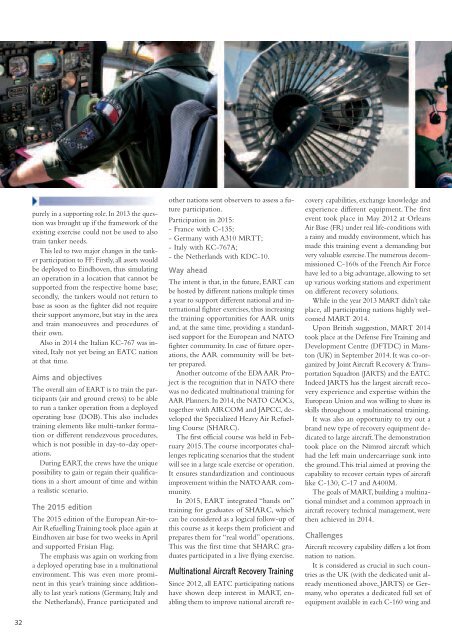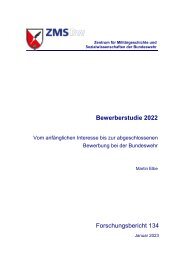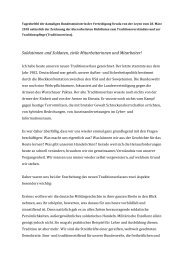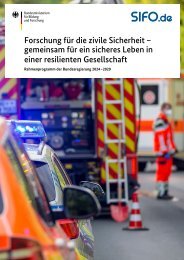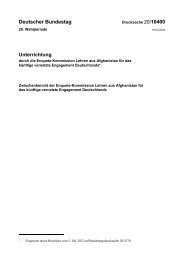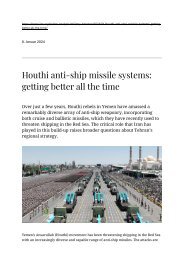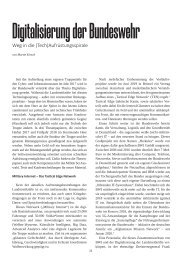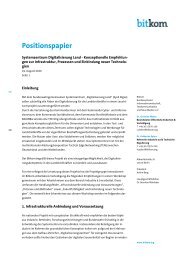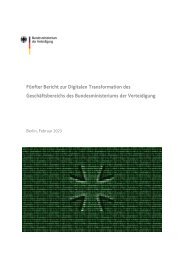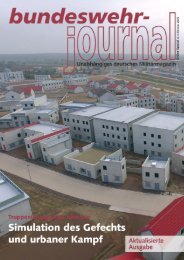EATC
You also want an ePaper? Increase the reach of your titles
YUMPU automatically turns print PDFs into web optimized ePapers that Google loves.
purely in a supporting role. In 2013 the question<br />
was brought up if the framework of the<br />
existing exercise could not be used to also<br />
train tanker needs.<br />
This led to two major changes in the tanker<br />
participation to FF: Firstly, all assets would<br />
be deployed to Eindhoven, thus simulating<br />
an operation in a location that cannot be<br />
supported from the respective home base;<br />
secondly, the tankers would not return to<br />
base as soon as the fighter did not require<br />
their support anymore,but stay in the area<br />
and train manoeuvres and procedures of<br />
their own.<br />
Also in 2014 the Italian KC-767 was invited,<br />
Italy not yet being an <strong>EATC</strong> nation<br />
at that time.<br />
Aims and objectives<br />
The overall aim of EART is to train the participants<br />
(air and ground crews) to be able<br />
to run a tanker operation from a deployed<br />
operating base (DOB). This also includes<br />
training elements like multi-tanker formation<br />
or different rendezvous procedures,<br />
which is not possible in day-to-day operations.<br />
During EART, the crews have the unique<br />
possibility to gain or regain their qualifications<br />
in a short amount of time and within<br />
a realistic scenario.<br />
The 2015 edition<br />
The 2015 edition of the European Air-to-<br />
Air Refuelling Training took place again at<br />
Eindhoven air base for two weeks in April<br />
and supported Frisian Flag.<br />
The emphasis was again on working from<br />
a deployed operating base in a multinational<br />
environment. This was even more prominent<br />
in this year’s training since additionally<br />
to last year’s nations (Germany, Italy and<br />
the Netherlands), France participated and<br />
other nations sent observers to assess a future<br />
participation.<br />
Participation in 2015:<br />
- France with C-135;<br />
- Germany with A310 MRTT;<br />
- Italy with KC-767A;<br />
- the Netherlands with KDC-10.<br />
Way ahead<br />
The intent is that, in the future, EART can<br />
be hosted by different nations multiple times<br />
a year to support different national and international<br />
fighter exercises, thus increasing<br />
the training opportunities for AAR units<br />
and, at the same time, providing a standardised<br />
support for the European and NATO<br />
fighter community. In case of future operations,<br />
the AAR community will be better<br />
prepared.<br />
Another outcome of the EDA AAR Project<br />
is the recognition that in NATO there<br />
was no dedicated multinational training for<br />
AAR Planners. In 2014, the NATO CAOCs,<br />
together with AIRCOM and JAPCC, developed<br />
the Specialized Heavy Air Refuelling<br />
Course (SHARC).<br />
The first official course was held in February<br />
2015.The course incorporates challenges<br />
replicating scenarios that the student<br />
will see in a large scale exercise or operation.<br />
It ensures standardization and continuous<br />
improvement within the NATO AAR community.<br />
In 2015, EART integrated “hands on”<br />
training for graduates of SHARC, which<br />
can be considered as a logical follow-up of<br />
this course as it keeps them proficient and<br />
prepares them for “real world” operations.<br />
This was the first time that SHARC graduates<br />
participated in a live flying exercise.<br />
Multinational Aircraft Recovery Training<br />
Since 2012, all <strong>EATC</strong> participating nations<br />
have shown deep interest in MART, enabling<br />
them to improve national aircraft recovery<br />
capabilities, exchange knowledge and<br />
experience different equipment. The first<br />
event took place in May 2012 at Orleans<br />
Air Base (FR) under real life-conditions with<br />
a rainy and muddy environment, which has<br />
made this training event a demanding but<br />
very valuable exercise.The numerous decommissioned<br />
C-160s of the French Air Force<br />
have led to a big advantage, allowing to set<br />
up various working stations and experiment<br />
on different recovery solutions.<br />
While in the year 2013 MART didn’t take<br />
place, all participating nations highly welcomed<br />
MART 2014.<br />
Upon British suggestion, MART 2014<br />
took place at the Defense Fire Training and<br />
Development Centre (DFTDC) in Manston<br />
(UK) in September 2014. It was co-organized<br />
by Joint Aircraft Recovery & Transportation<br />
Squadron (JARTS) and the <strong>EATC</strong>.<br />
Indeed JARTS has the largest aircraft recovery<br />
experience and expertise within the<br />
European Union and was willing to share its<br />
skills throughout a multinational training.<br />
It was also an opportunity to try out a<br />
brand new type of recovery equipment dedicated<br />
to large aircraft.The demonstration<br />
took place on the Nimrod aircraft which<br />
had the left main undercarriage sunk into<br />
the ground.This trial aimed at proving the<br />
capability to recover certain types of aircraft<br />
like C-130, C-17 and A400M.<br />
The goals of MART, building a multinational<br />
mindset and a common approach in<br />
aircraft recovery technical management, were<br />
then achieved in 2014.<br />
Challenges<br />
Aircraft recovery capability differs a lot from<br />
nation to nation.<br />
It is considered as crucial in such countries<br />
as the UK (with the dedicated unit already<br />
mentioned above, JARTS) or Germany,<br />
who operates a dedicated full set of<br />
equipment available in each C-160 wing and<br />
32


